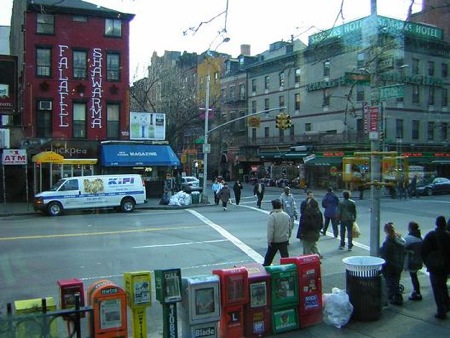East Village- Economy
From Decoding New York
| Introduction |
| The East Village |
| * Evolution |
| * Here v. There |
| * Economy |
| * What's Real |
| Bay Ridge |
| * Evolution |
| * Here v. There |
| * Economy |
| * What's Real |
| Comparison |
| * Photo Gallery |
| * Sources
|
Early resident John Jacob Astor, who arrived from Germany in 1784, became the first immigrant millionaire in the United States because of his success in the northwest fur trade and real estate investments in New Uork City. He was an exception. The Lower East Side and Kleindeutschland were largely working-class communities, where people were often lucky to have a place to sleep. Those who couldn't find a room sought refuge wherever possible in the streets. Jacob Riis, a police photographer, documented the squalid conditions in How the Other Half Lives, helping to bring much-needed reform to the area. The neighborhood housed many sweatshops at the turn of the 20th century and beyond. Immigrants from that period recall that, because tenements would sometimes offer tenants the first week free of rent, families would be constantly on the move, and children would come home from school and ask the neighbors where they were living today.
The first Yiddish theater in New York opened in 1882; by 1918, there were twenty of them in the city. They produced comedies and melodramas marketed towards the working classes. A unique brand of theater was the “greenhorn” play, which dealt with the immigrant experience. In 1891, Jacob Gordin, a Russian playwright, arrived in the city. Heralded as the “Jewish Ibsen” by intellectuals tired of what they called shund (trash) romances, Goldin promised to bring a more serious tone to Yiddish theater, starting off with Siberia and Jewish King Lear.
As the Village becomes increasingly trendy, and prices rise, the divide between the rich and poor grows wider. The East Village has become quite a tourist destination, and as such has a wide variety of establishments catering to visitors as well as locals. On the block of Houston Street between First Avenue and Avenue A, one restaurant advertises “Thailand Home Cooking”; next to it is a sign for “Himalayan Food”; next to that a fish & chips place; and at the corner, an Irish pub. While there is not a hugely evident Indian population, there are many Indian businesses around the mid-southern area, including seven Indian restaurants in a row on East Sixth Street between First and Second Avenues, and a Punjabi deli on Houston east of Second Avenue.
The East Village is home to some high-profile off-Broadway shows, including Blue Man Group and Stomp! which are located in theaters on Lafayette Street just about across the street from the Public Theater. The Public Theater originated as the free "Shakespeare in the Park" performances produced by Joseph Papp who then created the Public Theater to help develop and mount new plays all through the year. The Public Theater moved into the former Astor Library building in 1976 where it has several stages to accommodate a range of productions. Among the most famous productions of the Public Theater were "A Chorus Line," "Talk Radio, and "Bring in 'Da Noise, Bring in 'Da Funk." Nearby, on East Fourth Street, the New York Theater Workshop found space and began original productions in the early 1980s. Perhaps the most famous play developed under its aegis is "Rent." The Amato Opera Company has presented full scale performances in a tiny theater on the Bowery for more than 25 years and there are many other groups that moved to the area in the 1970s and 1980s because space in old theaters was inexpensive. By drawing people into the neighborhood to attend performances, they also fostered the opening of new restaurants and bars to serve these audiences, and thus were critical in the economic development of the East Village.
Jamie Martino, who lives in St. Mark's Place and spends most of her time there, believes that, "This is the place to be! I see the Orpheum Theater across the street. I've see Stomp at least three times. It's amazing and I always send my friends there. Throughout the show you see the nine cast members dancing and banging on trashcans, pipes, you name it. My favorite part was the portion they did with Zippo lighters. Everything is coordinated, and the vibe you get from it...I always know I am in the East Village." (Jamie Martino Interviews) In the southeastern Loisaida area, where one finds the greatest evidence of an ethnic community – such as the travel agent on First Avenue, just above Houston Street, with a sign in Spanish – businesses are less likely to have an “East Village” flavor, and more likely to simply serve the needs of the population.
